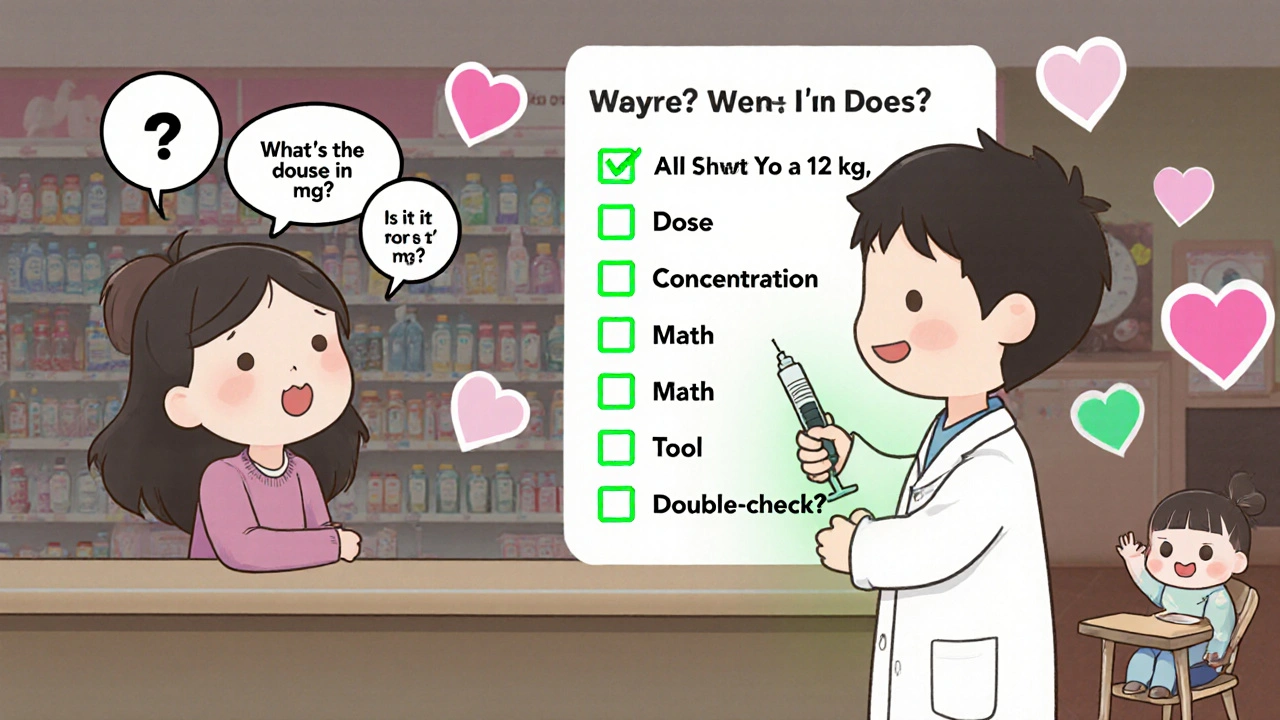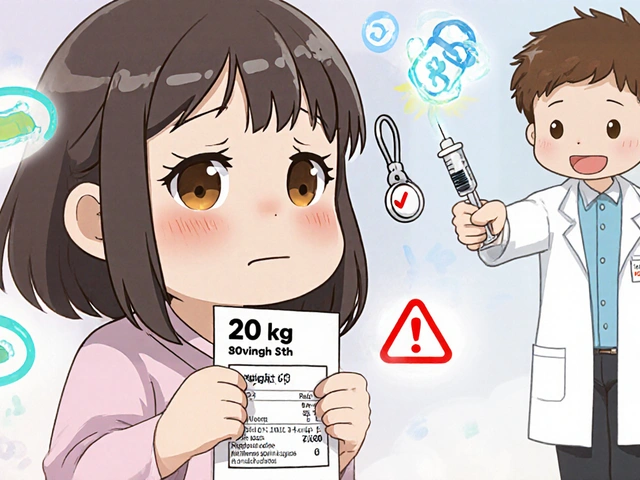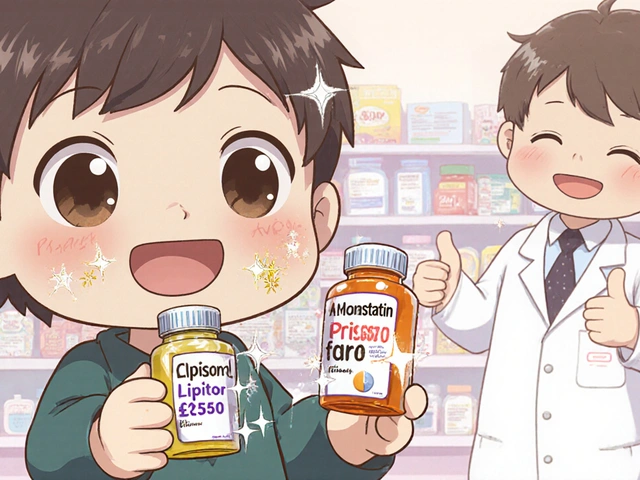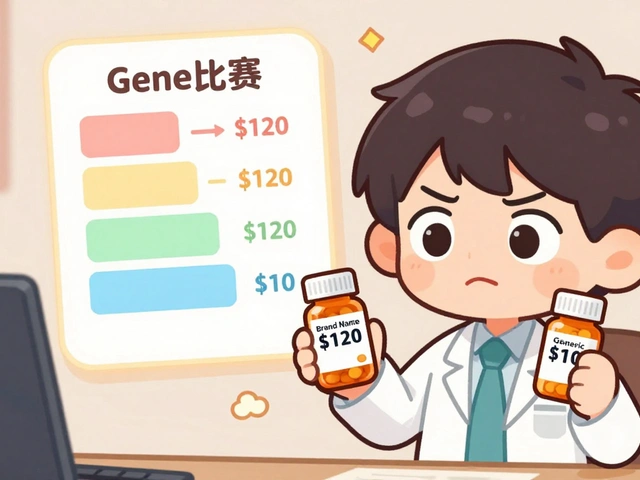Getting the right dose of medicine for your child isn’t just important-it’s life-or-death. Children aren’t small adults. Their bodies process drugs differently, and even a tiny mistake in dosage can lead to serious harm. In fact, pediatric dosing errors are three times more common than in adults, and more than half of those errors involve the amount of medicine given. The good news? You don’t have to guess. You can learn how to read and confirm the dose on your child’s prescription label with simple, proven steps.
Start with the weight-always in kilograms
The first thing you should check on any pediatric prescription is the child’s weight. It should be written in kilograms (kg), not pounds. If it’s not, ask the prescriber or pharmacist to add it. Why? Because every correct pediatric dose is calculated based on weight in kilograms. The standard conversion is 1 kg = 2.2 lb. But here’s where mistakes happen: many people round 2.2 to 2, or use the wrong number. A 22-pound child is exactly 10 kg-not 11, not 9.5. That half-kilogram difference can mean a 5% overdose. That’s dangerous with drugs like acetaminophen or antibiotics.Look for the dose in milligrams, not milliliters
A prescription might say: “Give 5 mL twice daily.” That tells you how much liquid to give-but not how much medicine is in it. You need to know the exact amount in milligrams (mg). Ask: “What is the dose in mg per dose?” A common error is confusing volume with strength. For example, amoxicillin comes in different concentrations: 40 mg/mL and 80 mg/mL. If the label says “5 mL,” but the concentration isn’t clearly stated, you could give 200 mg or 400 mg-double the dose. Always confirm: mg per mL and mg per dose. The FDA now requires this information on all pediatric liquid labels, but not every pharmacy follows it perfectly. Don’t assume.Check the calculation: mg/kg/dose
Most pediatric doses are written as mg per kg per dose. For example: “Amoxicillin 40 mg/kg/day divided every 12 hours.” That means you multiply the child’s weight (in kg) by 40 to get the total daily dose. Then divide by 2 if it’s given twice a day. So a 10 kg child would get 400 mg per day, or 200 mg per dose. If the label says “200 mg every 12 hours,” that matches. If it says “500 mg,” that’s too high. You can do this math yourself. Write it down. Don’t rely on memory. Pharmacists are trained to verify this, but you’re the last line of defense. If the dose doesn’t match the weight-based calculation, stop. Ask again.Know the concentration of the liquid
Liquid medications come in different strengths. The same drug, like ibuprofen or amoxicillin, can be sold as 100 mg/5 mL, 40 mg/mL, or 80 mg/mL. The bottle label must show this clearly. But if you’re handed a new bottle and the concentration changed from last time, the dose in mL might look the same-but the amount of medicine is different. One mother in Manchester caught a 3x overdose because her child’s amoxicillin switched from 40 mg/mL to 80 mg/mL, and she gave the same 5 mL dose. The pharmacist didn’t flag it. She checked the label, saw the same volume, and didn’t realize the concentration had changed. That’s why you must always compare the mg per mL on the bottle to the mg per dose on the prescription. If they don’t add up, it’s wrong.Use the measuring tool that came with the medicine
Never use a kitchen spoon. Never guess. Always use the syringe, dropper, or cup that came with the medication. Those tools are calibrated for that specific concentration. A teaspoon holds about 5 mL, but it’s not exact. A child’s dose might be 1.8 mL. If you’re using a syringe, you can measure that precisely. If you’re using a cup, make sure it has clear markings. Some pharmacies now provide oral syringes with pediatric doses pre-marked. Ask for one. If they don’t give you one, ask why. The CDC says over a third of liquid medication errors in kids under 2 happen because parents use the wrong measuring device.
Ask the three key questions
Before leaving the pharmacy, ask these three questions out loud:- What is the exact dose in milligrams (mg), not milliliters (mL)?
- Is this dose appropriate for my child’s current weight in kilograms?
- Can you show me how to measure this dose with the tool you’re giving me?
Watch out for rounding and tech errors
Electronic systems sometimes round doses to make them easier to measure. For example, a calculated dose of 157.8 mg might be rounded to 160 mg. That’s usually safe. But if it’s rounded down-say, 157.8 mg becomes 150 mg-that could mean the child isn’t getting enough medicine. Ask: “Was this dose rounded?” If yes, ask why. Some systems round differently based on the drug. For instance, doses under 10 mg are rounded to the nearest 0.1 mg; over 10 mg, to the nearest 1 mg. That’s standard in systems like Cerner and EPIC. But not every pharmacy uses the same rules. If you see a dose that seems unusually high or low, double-check the math. You can also ask: “What was the original calculated dose before rounding?”When in doubt, call the pharmacist
If something feels off, even if you can’t put your finger on why, call the pharmacy. Don’t wait until you get home. Call the same day. Say: “I’m reviewing my child’s prescription and want to confirm the dose matches their weight.” Most pharmacies have a pharmacist on call. You’re not bothering them. You’re doing your job as a caregiver. In one case, a mother in Manchester called after her child’s amoxicillin label said “10 mL” for a 16 kg child. She did the math: 10 mL of 80 mg/mL = 800 mg. That’s 50 mg/kg-way over the 40 mg/kg standard. The pharmacist admitted it was a data entry error and corrected it immediately.Parents are the final safety check
Even with all the technology-electronic records, smart pumps, AI verification tools-parents are still the last line of defense. No system is perfect. A 2023 study found that 43% of preventable pediatric medication errors happened because no one questioned the dose. That’s not the doctor’s fault. Not the pharmacist’s fault. It’s a system failure. But you can fix it. You don’t need to be a doctor. You just need to know how to read the label. Write down the weight. Write down the mg per dose. Write down the concentration. Do the math. Compare it to what you’ve been told. If it doesn’t match, speak up. Your child’s safety depends on it.
What if the label doesn’t have the weight or dose?
If the prescription label doesn’t include the child’s weight in kilograms or the calculated dose in milligrams, that’s a red flag. The American Academy of Pediatrics now requires this information on all pediatric prescriptions as of January 2024. If it’s missing, call the prescriber’s office. Ask them to send a corrected label. Don’t fill the prescription until you have it. This isn’t bureaucracy-it’s safety. In 2022, Pennsylvania reported that 29.8% of pediatric dosing errors came from missing or incorrect weight data. That’s preventable. You have the right to a clear, complete label.How technology is helping-and where it falls short
Hospitals and pharmacies are using better tools. Systems like EPIC and Cerner now flag doses that are too high or too low based on weight. AI tools like DoseSpot can cross-check a child’s dose against 15,000+ guidelines in seconds. But these tools only work if the data is correct. If the weight is entered as 22 lb instead of 10 kg, the system still gives the wrong answer. That’s why human verification still matters. The best systems require two people to confirm the dose. Pharmacists write: “Ordered: 40 mg/kg, Verified: 40 mg/kg.” That’s the gold standard. If you’re in a clinic or hospital, ask if the dose was double-checked. If you’re at a community pharmacy, ask if they have a pediatric dosing protocol. Most children’s hospitals do. Most general pharmacies don’t. That gap is real. And it’s dangerous.Real stories, real mistakes
One parent in Manchester nearly gave her 18-month-old a 3x overdose of acetaminophen because she confused two different concentrations. The old bottle was 160 mg/5 mL. The new one was 80 mg/0.8 mL. She didn’t realize the concentration changed. She gave 5 mL, thinking it was the same dose. It wasn’t. She caught it because she compared the label to the manufacturer’s dosing chart. That’s the kind of habit that saves lives. Another parent in Leeds didn’t question why her 3-year-old’s amoxicillin dose was 10 mL. She assumed it was right because the doctor wrote it. Later, she learned the dose should have been 200 mg total-about 2.5 mL of 80 mg/mL. She gave 800 mg. Her child got sick. She didn’t know how to check. She didn’t ask. That’s the story too many families live.Final checklist: Before you leave the pharmacy
Before you walk out with your child’s prescription, do this quick check:- Is the child’s weight written in kilograms (kg)?
- Is the dose listed in milligrams (mg), not just milliliters (mL)?
- Does the concentration (mg/mL) match the bottle you’re being given?
- Does the dose in mg match the weight-based calculation? (Weight in kg × mg/kg = total mg per dose)
- Are you being given the right measuring tool? (Syringe or dosing cup, not a spoon)
- Did the pharmacist confirm the dose was checked by two people?
How do I know if my child’s medication dose is correct?
To confirm your child’s dose is correct, first check that their weight is listed in kilograms on the prescription. Then, find the dose in milligrams (mg), not milliliters (mL). Multiply the weight in kg by the prescribed mg/kg dose to get the total amount. Compare that to the dose listed on the label. If they match, it’s likely correct. If not, ask the pharmacist to explain. For example, a 15 kg child on 15 mg/kg of amoxicillin should get 225 mg per dose. If the label says 225 mg, it’s right. If it says 450 mg, it’s wrong.
Why is it important to use the measuring tool that comes with the medicine?
Kitchen spoons and other measuring tools aren’t accurate. A teaspoon can hold anywhere from 3 to 7 mL. Pediatric doses are often very small-sometimes under 2 mL. Using the right syringe or dosing cup ensures you give exactly what’s prescribed. The tool that comes with the medicine is calibrated for that specific concentration. Using the wrong tool can lead to underdosing or overdosing, especially with antibiotics or pain relievers.
What should I do if the pharmacy gives me a new bottle with a different concentration?
If the concentration changes-even if the bottle looks the same-you must recalculate the dose. For example, if amoxicillin changes from 40 mg/mL to 80 mg/mL, the same volume now has twice as much medicine. Always ask: “What’s the new concentration?” and “How many mL should I give now?” Never assume the same number of mL is safe. A 2021 CDC report found this was the cause of over a third of liquid medication errors in children under 2.
Can I trust the dose printed on the label?
The label is a starting point, not a guarantee. Errors happen in data entry, rounding, or system glitches. Always verify the dose yourself using the child’s weight and the mg/kg calculation. If the label says 200 mg but your math says 150 mg, don’t give it. Call the pharmacy. You’re not being paranoid-you’re being responsible. Most pharmacists appreciate the extra check.
Why do some prescriptions say ‘mg/kg/day’ and others say ‘mg/kg/dose’?
‘mg/kg/day’ means the total daily dose. You have to divide that by how many times a day the medicine is given. For example, 40 mg/kg/day divided twice daily means 20 mg/kg/dose. ‘mg/kg/dose’ means each time you give it, that’s the full amount. Always check the frequency. If the label says “40 mg/kg/day, give every 12 hours,” you divide by 2. If it says “20 mg/kg/dose, every 12 hours,” you don’t divide. Confusing the two is a common error. Ask the pharmacist to clarify if you’re unsure.







Rebecca Cosenza
November 20, 2025 AT 21:21Always check the kg. Always. I once almost gave my kid double the dose because the pharmacist wrote ‘22 lbs’ and I assumed it was right. Never again. 🙏
swatantra kumar
November 22, 2025 AT 14:05Lmao at Americans needing a 10-step guide to read a medicine label. In India, we just eyeball it and pray to Shiva. 😇 But hey, at least you’ve got syringes. We use spoons and hope for the best. 🍴
Cinkoon Marketing
November 23, 2025 AT 06:25Actually, you missed something critical-most pharmacies don’t even have pediatric dosing protocols. I work in a clinic and we had to push for 6 months just to get a standardized chart. And don’t get me started on how often the EHR auto-fills weight from the last visit. I’ve seen 5-year-olds with 10-year-old weights in the system. It’s wild. 🤦♀️
robert cardy solano
November 24, 2025 AT 14:24Been there. My daughter got amoxicillin twice and both times the concentration was different. First time I didn’t catch it. Second time I did. Now I carry a calculator in my purse. Just in case. 🧮
Pawan Jamwal
November 25, 2025 AT 19:52USA needs a manual to give a child medicine? We give paracetamol by the teaspoon in rural India and kids grow up fine. This is overengineering. 🇮🇳
Bill Camp
November 26, 2025 AT 00:26THIS IS WHY AMERICA IS DYING. You people are so paranoid about medicine you can’t even give a kid a cough drop without a PhD in pharmacology. This is why we have a mental health crisis. Stop overthinking. Let kids be kids.
Lemmy Coco
November 27, 2025 AT 06:39just wanna say i used to use a kitchen spoon until my niece got sick from an overdose and now i only use the syringe and i triple check the mg/kg and i write it down on a napkin and show it to the pharmacist and sometimes they look at me like im crazy but i dont care because my kid is alive 🙏
rob lafata
November 27, 2025 AT 09:22Let me guess-you’re the type who also checks the expiration date on milk and screams at the barista if the latte isn’t ‘exactly 16.9 oz.’ This isn’t medicine, it’s performance art. You’re not a parent, you’re a compliance officer with a toddler. And no, I don’t trust your ‘calculation.’ I trust my gut. And my gut says you’re the reason pharmacies now require a notarized form just to get Tylenol.
Matthew McCraney
November 28, 2025 AT 02:15EVERY SINGLE ONE OF THESE STEPS IS A GOVERNMENT PLOY TO MAKE YOU DEPENDENT ON PHARMACISTS. The CDC? FDA? They’re all part of the Big Pharma cabal. I’ve been giving my kids liquid ibuprofen from a dropper I bought at the gas station since 2018. No one’s died yet. But the system? Oh, they’re watching. They’re recording your weight. They’re tracking your doses. You think this is about safety? It’s about control. And they want you to be scared.
serge jane
November 29, 2025 AT 15:10It’s funny how we’ve turned parenting into an engineering problem. We’ve got checklists and calculators and syringes and weight charts-but we’ve forgotten that love is the most accurate dosing algorithm. I’ve seen kids get the wrong dose and still bounce back because their mom held them tight and sang to them. The math matters, sure. But the human connection? That’s the real medicine. We’ve forgotten that. We’re so busy verifying mg/kg that we’ve stopped noticing when our kid’s eyes light up when they see us walk in the room. Maybe the real safety net isn’t on the label-it’s in the hug.
Nick Naylor
November 30, 2025 AT 23:55Per FDA 21 CFR §201.100(a)(3), pediatric labeling must include: (1) weight in kilograms; (2) dose in milligrams; (3) concentration in mg/mL; (4) calibrated dosing device; and (5) double-verification protocol. Non-compliance constitutes a Class II recall. If your pharmacy fails to provide all five, file a MedWatch report. Immediately. This isn’t opinion. It’s codified law. You’re not being ‘overcautious.’ You’re exercising your statutory right under the Pediatric Research Equity Act. Don’t let them gaslight you into silence.
Brianna Groleau
December 2, 2025 AT 10:18I’m from Nigeria and we don’t have all this fancy syringe stuff. We use a clean teaspoon and say a prayer. But after reading this, I’m going to try the weight-in-kg thing. My cousin’s baby got sick last year from a wrong dose, and I’ve been scared ever since. I don’t know much about medicine, but I know love. And love means trying harder. So I’ll learn. I’ll write it down. I’ll ask. Because my child deserves that. And so do yours. ❤️
Rusty Thomas
December 3, 2025 AT 13:44Okay, but what if the pharmacist is a total jerk? I asked a question once and they rolled their eyes and said, ‘If you don’t trust us, go to a hospital.’ I cried in the parking lot. Then I went back with a printed copy of this article and they gave me a free lollipop. So… it worked? 🍭